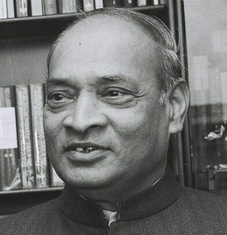
America Doesn't Have the Worst Election System
Last updated: Friday July 14th, 2023
Report this blog
Most people know about the infamous electoral college of the United States, which became particularly notorious in the 2016 election between the Republican candidate, Donald Trump, and the Democratic candidate, Hillary Clinton. Trump won nearly 63 million votes, and Clinton won nearly 66 million, giving Clinton a nearly 3 million vote lead. However, through the electoral college, this translated to Trump getting 304 electoral votes, and Clinton getting 227 votes, giving Trump a massive 77 vote lead and him becoming President.

However, a similar thing happened in India in 1996. The candidate for the BJP was Atal Bihari Vajpayee, and the opponent was the INC’s P. V. Narasimha Rao. Out of nearly 335 million votes, Vajpayee gained 68 million votes, and Narasimha Rao got an overwhelming 96 million votes, giving him a massive lead of 30 million votes. However, this won the BJP 161 seats out of 543 in the Lok Sabha, India’s lower house of parliament, and the INC got a measly 140, meaning the BJP got 21 more seats than the INC this election. Yes, Narasimha Rao’s party gained 40% more votes than Vajpayee’s party, yet Vajpayee still got more seats.
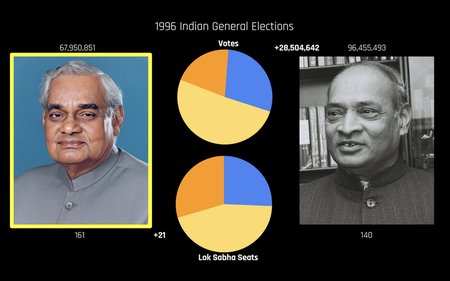
So why is it like this? In this blog, I'll go over how the Indian Prime Minister is elected, compare it with American Presidential elections, and show some problems in the system.
American Presidential Elections
I’ll start with how the American president is elected. There are 538 electoral votes available for each candidate to win, which are given to the 50 states. 100 of those votes are divided evenly between the states, giving each state 2 votes. 435 of the remaining votes are distributed among the 50 states based on their population according to the last census, which happens every 10 years. The more populous a state is, the more electoral votes they will have. Finally, the remaining 3 electoral votes represent the District of Columbia, the capital, which isn’t part of any state.
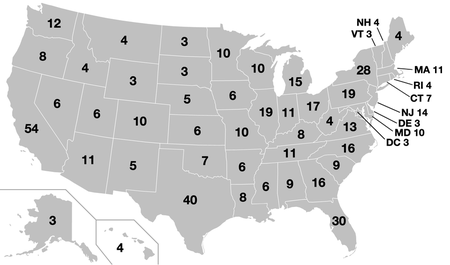
For example, the most populous state, California, which had nearly 40 million people in 2020, will have 54 electoral votes for the 2024 election, 52 due to it having a lot of people, and 2 because every state gets 2 electoral votes. However, Wyoming, with just 570,000 people, will get 3 votes in total. 1 vote due to its tiny population, and 2 votes because every state gets 2 more votes.
Now what do these electoral votes do? During presidential elections, every state holds an election between all the candidates running for the role. In most cases, the votes are tallied up in each state, and the person with the most votes wins all the electoral votes of the state. So even if a candidate wins only 50% of California’s votes, he gets all 54 of the state’s electoral votes. This happens in 48 of the states (Maine and Nebraska actually divide their votes according to their congressional districts, so that's slightly better) and the District of Columbia, and the person who gets at least 270 votes, which is half the number of votes in the electoral college, wins the election and becomes president. There are a lot of details that I have gone over here, but this is the general idea.
Indian General Elections
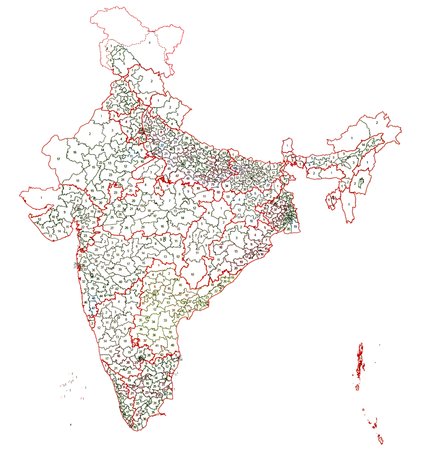
However, India’s Prime Minister is elected differently, in a way almost identical to the UK. The Prime Minister is technically appointed by the President, but they need to be approved by at least half the members of the Lok Sabha, the lower house of Parliament in India. India is divided into 543 constituencies where an election for each seat in the Lok Sabha is held. Candidates campaign and get voted on by the residents of each constituency, and the person with the most votes in their constituency wins the seat and represents the constituency in the Lok Sabha.
The winners of the different seats, who are usually affiliated with a party, then meet and decide on the new prime minister. Often, the larger parties don’t get the 50% of the seats needed to choose whatever Prime Minister they want, so they will sometimes have to form a coalition government with smaller parties to gain half the seats and select the prime minister, often making concessions to these parties in policies, cabinet positions, and other things. As I said before, the Prime Minister is technically appointed by the President, but the President is more of a figurehead, and it’s usually the members of the Lok Sabha that decide the Prime Minister.
So what happened in 1996? To look at this, we have to look at some problems in the system.
Problems With This System
One major problem with this system is in the constituency size. In the US, the votes of the electoral college are mostly distributed on the basis of population, while in India, there is a massive range in each constituency. The smallest constituency is Lakshadweep islands, with a population of 60,000, and the largest one is Malkajgiri, Telangana, with 3 million people. This means that if one party wins all the votes in Lakshadweep and another wins all the votes in Malkajgiri, they will be represented equally, even though Lakshadweep has only 2% of the population of Malkajgiri. This means that a vote from Lakshadweep is worth more than a vote from Malkajgiri. The American electoral college also has this problem, but on a smaller scale. The people-per-vote ratio in Wyoming is 190,000, while California’s is 740,000. There is a big range here, but it’s much smaller than India’s 3-million-to-60,000 range.

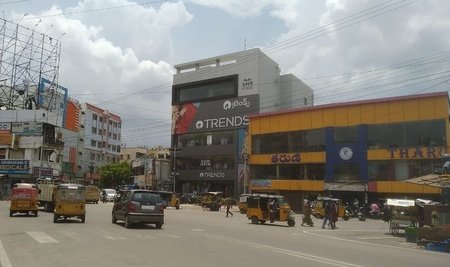
Another problem is that the winner in each constituency doesn’t have to win the majority of the votes, just the plurality. This is the same in the US, but since there are only 2 mainstream parties, this problem isn’t as large because they will usually win a majority. However, in India, there are a ton of national and regional parties, as well as independent candidates, who contest for every seat, meaning that the winner doesn’t normally have 50% of the vote and therefore doesn’t have the support of most people in their constituency. This makes it possible for a large party across the nation to win millions of votes across many constituencies, yet not win a single seat because it failed to attain a plurality of votes in any constituency.
The 1996 Elections
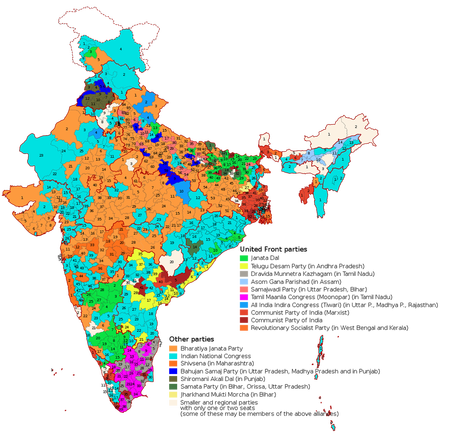
What happened in 1996 was a combination of these two problems. The INC won the more urban, populated constituencies, but although they gained a lot of votes in rural constituencies, they didn’t get the most votes and couldn’t win many seats.
Because the BJP was the largest party, the president appointed Vajpayee as Prime Minister, but he had to prove he was supported by the majority of people within 2 weeks. However, he was unable to do this and resigned within 13 days. This resulted in another party being allowed to form a government, and ultimately, the smaller Janata Dal party, with the backing of the INC, was able to make a relatively stable government.
Edit: Charts On Indian General Elections
Aficionado has made some charts on the Indian General Elections, specifically on the amount of votes each party got and how many seats they got. They do reveal some interesting things, and prove my point again. You can notice how the graphs are not similar, meaning the votes aren't proportionally represented. Also, an interesting fact is that despite no party ever winning over 50% of the vote, absolute majorities were formed by a single party in 10 of the 17 general elections. This shows how unrepresentative the Lok Sabha is of the popular vote.
So yes, this is my first blog. I might make it into a video if I feel motivated enough. Please give me your opinion on this blog, and tell me if there are any factual inaccuracies so they can be corrected. Thank you for reading!

According to Arrow's theorem, an election with more than two candidates and two electors is just a manipulayion by the choice of the voting system. So yeah, nothing is perfect, but electoral weight of the different constituencies is definitely undecent. In France, people complain for a 163 019/64 199 range. Not normal but still better that the infamouus Indian one.
Also, I would say that the multiple parties are an advantage of the Indian system over the Unitedstatesian. Bipartism has a big problem of representation, so even if parties don't need a majority, at least they represent the diverse opinions of the Indian population better than in the United States.
Anyway, that's just what I think. Great first blog!
However, India's voting system in the constituencies highlights that it is possible, even probable, that candidates win with less than 50% of the vote, which is particularly amplified with so many parties. They will split the vote so much that it the winning candidate doesn't even have the majority of popular vote.